
European social model
Encyclopedia
The European social model is a term used to describe a common vision many European states have for a society that combines economic growth
with high living standards and good working conditions. Historian Tony Judt
has argued that the 'European social model' "binds Europe together" in contrast to the 'American way of life'.
European states do not all use a single social model
, but welfare states
in Europe
do share several broad characteristics. These generally include a commitment to full employment
, social protection
s for all citizens, social inclusion, and democracy
. The Treaty of the European Community set out several social objectives: promotion of employment, improved living and working conditions ... proper social protection, dialogue between management and labour, the development of human resources with a view to lasting high employment and the combating of exclusion. Because different European states focus on different aspects of the model, it has been argued that there are four distinct social models in Europe — the Nordic, Anglo-Saxon, Mediterranean and the Continental.
The general outlines of a European social model emerged during the post-war boom
. Tony Judt lists a number of causes: the abandonment of protectionism
, the baby boom
, cheap energy and a desire to catch up with living standards enjoyed in the United States. The European social model also enjoyed a low degree of external competition as the Soviet bloc, China and India were not yet integrated into the global economy. In recent years, it has become common to question whether the European social model is sustainable in the face of globalization
, Europeanisation
and an ageing population.
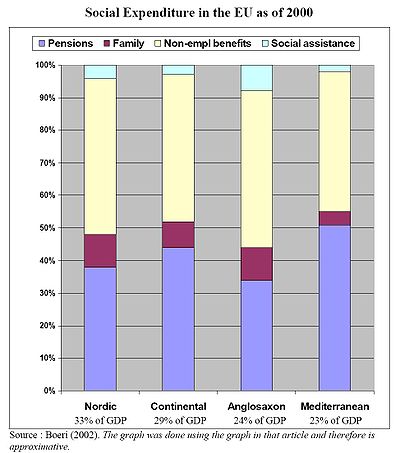 Some of the European welfare states have been described as the most well developed and extensive. It is a common argument saying that there exists a unique "European social model", in contrast with the social model existing in the US. The truth is that the reality is more complex. Economists have agreed on the fact that there exist different social models in the EU
Some of the European welfare states have been described as the most well developed and extensive. It is a common argument saying that there exists a unique "European social model", in contrast with the social model existing in the US. The truth is that the reality is more complex. Economists have agreed on the fact that there exist different social models in the EU
. Although each European country has its own singularities, one can distinguish four different welfare or social models in Europe :
. Its main characteristic is its universal provision nature which is based on the principle of "citizenship". Therefore, there exists a more generalized access, with lower conditionability, to the social provisions.
As regards labour market, these countries are characterized by important expenditures in active labour market policies
whose aim is a rapid reinsertion of the unemployed
into the labour market. These countries are also characterized by a high share of public employment. Trade union
s have a high membership and an important decision-making power which induces a low wage
dispersion or more equitable income distribution.
The Nordic model is also characterized by a high tax wedge
.
As regards the labour market, active policies are less important than in the Nordic model and in spite of a low membership rate, trade-unions have important decision-making powers in collective agreement
s.
Another important aspect of the Continental model are the invalidity subsidies.
Active labour market policies are important. Instead, trade unions have a smaller decision-making power than in the previous models, this is one of the reasons explaining their higher income dispersion and their higher number of low-wage employments.
later than the previous ones (during the seventies and eighties). It is the model with lowest share of expenditures and is strongly based on pensions and a low level of social assistance. There exists in these countries a higher segmentation of rights and status of persons receiving subsidies which has as one of its consequences a strongly conditioned access to social provisions.
The main characteristic of labour market policies is a rigid employment protection legislation
and a frequent resort to early retirement policies as a means to improve employment conditions. Trade unions tend to have an important membership which again is one of the explanations behind a lower income dispersion than in the Anglosaxon model.
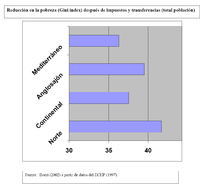
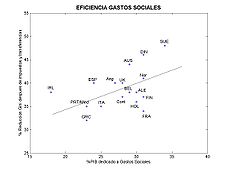 The graph on the left shows the reduction in inequality (as measured by the Gini index) after taking account of taxes and transfers, that is, to which extent does each social model reduce poverty without taking into account the reduction in poverty provoqued by taxes and transfers. The level of social expenditures is an indicator of the capacity of each model to reduce poverty: a bigger share of expenditures is in general associated to a higher reduction in poverty. Nevertheless, another aspect that should be taken into account is the efficiency in this poverty reduction. By this is meant that with a lower share of expenditures a higher reduction in poverty may be obtained.
The graph on the left shows the reduction in inequality (as measured by the Gini index) after taking account of taxes and transfers, that is, to which extent does each social model reduce poverty without taking into account the reduction in poverty provoqued by taxes and transfers. The level of social expenditures is an indicator of the capacity of each model to reduce poverty: a bigger share of expenditures is in general associated to a higher reduction in poverty. Nevertheless, another aspect that should be taken into account is the efficiency in this poverty reduction. By this is meant that with a lower share of expenditures a higher reduction in poverty may be obtained.
In this case, the graph on the right shows that the Anglosaxon and Nordic models are more efficient than the Continental or Mediterranean ones. The Continental model appears to be the least efficient. Given its high level of social expenditures, one would expect a higher poverty reduction than that attained by this model. Remark how the Anglosaxon model is found above the average line drawn whereas the Continental is found below that line.
As can be seen in the graph, there is a clear trade-off between these two types of labour market instruments (remark the clear negative slope between both). Once again different European countries have chosen a different position in their use of these two mechanisms of labour market protection. These differences can be summarized as follows:
Evalutating the different choices is a hard task. In general there exists consensus among economists on the fact that employment protection generates inefficiencies inside firms. Instead, there is no such consensus as regards the question of whether employment protection generates a higher level of unemployment.
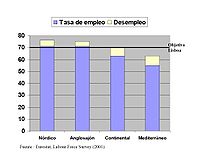 Sapir (2005) and Boeri (2002) propose looking at the Employment-to-Population ratio
Sapir (2005) and Boeri (2002) propose looking at the Employment-to-Population ratio
as the best way to analyze the incentives and rewards for employment in each social model. The Lisbon Strategy
initiated in 2001 established that the members of the EU should attain a 70% employment rate by 2010.
In this case, the graph shows that the countries in the Nordic and Anglosaxon model are the ones with the highest employment rate whereas the Continental and Mediterranean countries have not attained the Lisbon Strategy target.
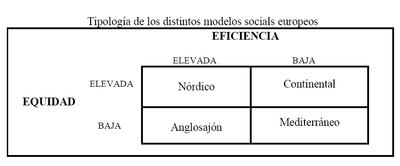 .
.
Sapir (2005) proposes as a general mean to evaluate the different social models, the following two criteria:
As can be seen in the graph, according to these two criteria, the best performance is achieved by the Nordic model. The Continental model should improve its efficiency whereas the Anglosaxon model its equity. The Mediterranean model underperforms in both criteria.
Some economists consider that between the Continental model and the Anglosaxon, the latter should be preferred given its better results in employment, which make it more sustainable in the long term, whereas the equity level depends on the preferences of each country (Sapir, 2005). Other economists argue that the Continental model cannot be considered worse than the Anglosaxon given that it is also the result of the preferences of those countries that support it (Fitoussi et al., 2000; Blanchard, 2004). This last argument can be used to justify any policy.
Location specific:
Economic growth
In economics, economic growth is defined as the increasing capacity of the economy to satisfy the wants of goods and services of the members of society. Economic growth is enabled by increases in productivity, which lowers the inputs for a given amount of output. Lowered costs increase demand...
with high living standards and good working conditions. Historian Tony Judt
Tony Judt
Tony Robert Judt FBA was a British historian, essayist, and university professor who specialized in European history. Judt moved to New York and served as the Erich Maria Remarque Professor in European Studies at New York University, and Director of NYU's Erich Maria Remarque Institute...
has argued that the 'European social model' "binds Europe together" in contrast to the 'American way of life'.
European states do not all use a single social model
Social Model
A social, or socioeconomic, model, is the value system associated with the structure of a nation's political economy. There are no set rules that define a social model, only loose definitions characterized by certain attributes.-Taxation:...
, but welfare states
Welfare state
A welfare state is a "concept of government in which the state plays a key role in the protection and promotion of the economic and social well-being of its citizens. It is based on the principles of equality of opportunity, equitable distribution of wealth, and public responsibility for those...
in Europe
Europe
Europe is, by convention, one of the world's seven continents. Comprising the westernmost peninsula of Eurasia, Europe is generally 'divided' from Asia to its east by the watershed divides of the Ural and Caucasus Mountains, the Ural River, the Caspian and Black Seas, and the waterways connecting...
do share several broad characteristics. These generally include a commitment to full employment
Full employment
In macroeconomics, full employment is a condition of the national economy, where all or nearly all persons willing and able to work at the prevailing wages and working conditions are able to do so....
, social protection
Social protection
Social protection, as defined by the United Nations Research Institute For Social Development, is concerned with preventing, managing, and overcoming situations that adversely affect people’s well being...
s for all citizens, social inclusion, and democracy
Democracy
Democracy is generally defined as a form of government in which all adult citizens have an equal say in the decisions that affect their lives. Ideally, this includes equal participation in the proposal, development and passage of legislation into law...
. The Treaty of the European Community set out several social objectives: promotion of employment, improved living and working conditions ... proper social protection, dialogue between management and labour, the development of human resources with a view to lasting high employment and the combating of exclusion. Because different European states focus on different aspects of the model, it has been argued that there are four distinct social models in Europe — the Nordic, Anglo-Saxon, Mediterranean and the Continental.
The general outlines of a European social model emerged during the post-war boom
Post-World War II economic expansion
The post–World War II economic expansion, also known as the postwar economic boom, the long boom, and the Golden Age of Capitalism, was a period of economic prosperity in the mid 20th century, which occurred mainly in western countries, followed the end of World War II in 1945, and lasted until the...
. Tony Judt lists a number of causes: the abandonment of protectionism
Protectionism
Protectionism is the economic policy of restraining trade between states through methods such as tariffs on imported goods, restrictive quotas, and a variety of other government regulations designed to allow "fair competition" between imports and goods and services produced domestically.This...
, the baby boom
Post-World War II baby boom
The end of World War II brought a baby boom to many countries, especially Western ones. There is some disagreement as to the precise beginning and ending dates of the post-war baby boom, but it is most often agreed to begin in the years immediately after the war, ending more than a decade later;...
, cheap energy and a desire to catch up with living standards enjoyed in the United States. The European social model also enjoyed a low degree of external competition as the Soviet bloc, China and India were not yet integrated into the global economy. In recent years, it has become common to question whether the European social model is sustainable in the face of globalization
Globalization
Globalization refers to the increasingly global relationships of culture, people and economic activity. Most often, it refers to economics: the global distribution of the production of goods and services, through reduction of barriers to international trade such as tariffs, export fees, and import...
, Europeanisation
Europeanisation
Europeanisation refers to a number of related phenomena and patterns of change:*The process in which a notionally non-European subject adopts a number of European features...
and an ageing population.
Welfare state in Europe

European Union
The European Union is an economic and political union of 27 independent member states which are located primarily in Europe. The EU traces its origins from the European Coal and Steel Community and the European Economic Community , formed by six countries in 1958...
. Although each European country has its own singularities, one can distinguish four different welfare or social models in Europe :
- The Nordic model, in Denmark, Finland, Norway, Sweden and the Netherlands.
- The Continental model, in Austria, Belgium, France, Germany and Luxembourg.
- The Anglosaxon model, in Ireland and Great Britain.
- The Mediterranean model, in Greece, Italy, Portugal and Spain.
Nordic model
As can be seen in the graph to the right, this model holds the highest level of social insuranceSocial insurance
Social insurance is any government-sponsored program with the following four characteristics:* the benefits, eligibility requirements and other aspects of the program are defined by statute;...
. Its main characteristic is its universal provision nature which is based on the principle of "citizenship". Therefore, there exists a more generalized access, with lower conditionability, to the social provisions.
As regards labour market, these countries are characterized by important expenditures in active labour market policies
Active labour market policies
Active labour market policies are government programmes that intervene in the labour market to help the unemployed find work. Many of these programmes grew out of earlier public works projects designed to combat widespread unemployment in the developed world during the interwar period...
whose aim is a rapid reinsertion of the unemployed
Unemployment
Unemployment , as defined by the International Labour Organization, occurs when people are without jobs and they have actively sought work within the past four weeks...
into the labour market. These countries are also characterized by a high share of public employment. Trade union
Trade union
A trade union, trades union or labor union is an organization of workers that have banded together to achieve common goals such as better working conditions. The trade union, through its leadership, bargains with the employer on behalf of union members and negotiates labour contracts with...
s have a high membership and an important decision-making power which induces a low wage
Wage
A wage is a compensation, usually financial, received by workers in exchange for their labor.Compensation in terms of wages is given to workers and compensation in terms of salary is given to employees...
dispersion or more equitable income distribution.
The Nordic model is also characterized by a high tax wedge
Tax wedge
The tax wedge is the deviation from equilibrium price/quantity as a result of a taxation, which results in consumers paying more, and suppliers receiving less....
.
Continental model
The Continental model has some similarities with the Nordic model. Nevertheless, it has a higher share of its expenditures devoted to pensions. The model is based on the principle of "security" and a system of subsidies which are not conditioned to employability (for example in the case of France or Belgium, there exist subsidies whose only requirement is being older than 25).As regards the labour market, active policies are less important than in the Nordic model and in spite of a low membership rate, trade-unions have important decision-making powers in collective agreement
Collective agreement
A collective agreement or collective bargaining agreement is an agreement between employers and employees which regulates the terms and conditions of employees in their workplace, their duties and the duties of the employer...
s.
Another important aspect of the Continental model are the invalidity subsidies.
Anglo-Saxon model
This model features a lower level of expenditures than the previous ones. Its main particularity is its social assistance of last resort. Subsidies are directed to a higher extent to the working-age population and to a lower extent to pensions. Access to subsidies is (more) conditioned to employability (for instance, they are conditioned on having worked previously).Active labour market policies are important. Instead, trade unions have a smaller decision-making power than in the previous models, this is one of the reasons explaining their higher income dispersion and their higher number of low-wage employments.
Mediterranean model
This model corresponds to southern European countries who developed their welfare stateWelfare state
A welfare state is a "concept of government in which the state plays a key role in the protection and promotion of the economic and social well-being of its citizens. It is based on the principles of equality of opportunity, equitable distribution of wealth, and public responsibility for those...
later than the previous ones (during the seventies and eighties). It is the model with lowest share of expenditures and is strongly based on pensions and a low level of social assistance. There exists in these countries a higher segmentation of rights and status of persons receiving subsidies which has as one of its consequences a strongly conditioned access to social provisions.
The main characteristic of labour market policies is a rigid employment protection legislation
Employment Protection Legislation
Employment protection legislation refers to all types of employment protection measures, whether grounded primarily in legislation, court rulings, collectively bargained conditions of employment or customary practice. The term is common among circles of economists. Employment protection refers...
and a frequent resort to early retirement policies as a means to improve employment conditions. Trade unions tend to have an important membership which again is one of the explanations behind a lower income dispersion than in the Anglosaxon model.
Evaluating the different social models
In order to evaluate the different social models, we follow the criteria used in Boeri (2002) and Sapir (2005) which consider that a social model should satisfy the following:- Reduction in poverty.
- Protection against labour market risks.
- Rewards for labour participation.
Reduction in poverty


In this case, the graph on the right shows that the Anglosaxon and Nordic models are more efficient than the Continental or Mediterranean ones. The Continental model appears to be the least efficient. Given its high level of social expenditures, one would expect a higher poverty reduction than that attained by this model. Remark how the Anglosaxon model is found above the average line drawn whereas the Continental is found below that line.
Protection against labour market risks
Protection against labour market risks is generally assured by two means:- RegulationRegulationRegulation is administrative legislation that constitutes or constrains rights and allocates responsibilities. It can be distinguished from primary legislation on the one hand and judge-made law on the other...
of the labour market by means of employment protection legislation which basically increases firing costs and severance payments for the employers. This is generally referred to as providing "employment" protection. - Unemployment benefitUnemployment benefitUnemployment benefits are payments made by the state or other authorized bodies to unemployed people. Benefits may be based on a compulsory para-governmental insurance system...
s which are commonly financed with taxes or mandatory public insurances to the employees and employers. This is generally referred to as providing protection to the "worker" as opposed to "employment".
As can be seen in the graph, there is a clear trade-off between these two types of labour market instruments (remark the clear negative slope between both). Once again different European countries have chosen a different position in their use of these two mechanisms of labour market protection. These differences can be summarized as follows:
- The Mediterranean countries have chosen a higher "employment" protection while a very low share of their unemployed workers receives unemployment benefits.
- The Nordic countries have chosen to protect to a lesser extent "employment" and instead, an important share of their unemployed workers receives benefits.
- The continental countries have a higher level of both mechanisms than the European average, although by a small margin.
- The anglosaxon countries base their protection on unemployment benefits and a low level of employment protection.
Evalutating the different choices is a hard task. In general there exists consensus among economists on the fact that employment protection generates inefficiencies inside firms. Instead, there is no such consensus as regards the question of whether employment protection generates a higher level of unemployment.
Rewards for labour participation

Employment-to-population ratio
The Organization for Economic Co-operation and Development defines the employment rate as the employment-to-population ratio. This is a statistical ratio that measures the proportion of the country's working-age population that is employed...
as the best way to analyze the incentives and rewards for employment in each social model. The Lisbon Strategy
Lisbon Strategy
The Lisbon Strategy, also known as the Lisbon Agenda or Lisbon Process, was an action and development plan devised in 2000, for the economy of the European Union between 2000 and 2010....
initiated in 2001 established that the members of the EU should attain a 70% employment rate by 2010.
In this case, the graph shows that the countries in the Nordic and Anglosaxon model are the ones with the highest employment rate whereas the Continental and Mediterranean countries have not attained the Lisbon Strategy target.
Conclusion

Sapir (2005) proposes as a general mean to evaluate the different social models, the following two criteria:
- Efficiency, that is, whether the model provides the incentives so as to achieve the largest number possible of employed persons, that is, the highest employment rate.
- Equity, that is, whether the social model achieves a relatively low povertyPovertyPoverty is the lack of a certain amount of material possessions or money. Absolute poverty or destitution is inability to afford basic human needs, which commonly includes clean and fresh water, nutrition, health care, education, clothing and shelter. About 1.7 billion people are estimated to live...
risk.
As can be seen in the graph, according to these two criteria, the best performance is achieved by the Nordic model. The Continental model should improve its efficiency whereas the Anglosaxon model its equity. The Mediterranean model underperforms in both criteria.
Some economists consider that between the Continental model and the Anglosaxon, the latter should be preferred given its better results in employment, which make it more sustainable in the long term, whereas the equity level depends on the preferences of each country (Sapir, 2005). Other economists argue that the Continental model cannot be considered worse than the Anglosaxon given that it is also the result of the preferences of those countries that support it (Fitoussi et al., 2000; Blanchard, 2004). This last argument can be used to justify any policy.
See also
- Disability pensionDisability pensionA disability pension is a form of pension given to those people who are permanently or temporarily unable to work due to a disability. It is distinct from welfare.- North America :...
- Social insuranceSocial insuranceSocial insurance is any government-sponsored program with the following four characteristics:* the benefits, eligibility requirements and other aspects of the program are defined by statute;...
- Social ProtectionSocial protectionSocial protection, as defined by the United Nations Research Institute For Social Development, is concerned with preventing, managing, and overcoming situations that adversely affect people’s well being...
- Social securitySocial securitySocial security is primarily a social insurance program providing social protection or protection against socially recognized conditions, including poverty, old age, disability, unemployment and others. Social security may refer to:...
- Social welfare provision
- Welfare stateWelfare stateA welfare state is a "concept of government in which the state plays a key role in the protection and promotion of the economic and social well-being of its citizens. It is based on the principles of equality of opportunity, equitable distribution of wealth, and public responsibility for those...
Location specific:
- Tax rates of EuropeTax rates of EuropeThis is a list of the maximum potential tax rates around Europe for certain income brackets. It is focused on three types of taxes: corporate and individual taxes and value added taxes...
- U.S. welfare state

